Time: L+404 (December 2014) Temperature: +1 ˚C (DDU)
Week: 58 Sunlight: Most of the day (DDU)
Morale: Bad
Leaving Concordia was harder than expected.
At 05:00 in the morning I came down those long stairs one last time (the same stairs I used to rush up and down every day during winter). Outside the ice was dyed in hues of orange, touched by the early sun, a peaceful illumination that was in contrast with our feelings of departure. I had three pieces of luggage to carry, the rest of my stuff would be shipped back in the following months. But the heaviest thing was the emotional burden inside.
I am not going to lie – I had tears in my eyes as I stepped on the plane. It was mainly the people that I would miss, not only the place that generated this feeling. A lot of good friends from last winter and this summer campaign woke up early to see us off. I hugged most of them twice as we exchanged invitations for a future meeting. There is something shared among people in Antarctica that is not easy to explain. You might know them just for a few weeks, but they constitute a part of the puzzle of your life in the cold. I remembered all the moments walking on the ice every Sunday, playing basketball at –30 degrees, working in the ESA Lab, playing tavli (backgammon), making photos and cleaning the dishes! Each of those moments is a little treasure. As we stepped on the tiny airplane and the door was shut behind us, the pilots prepped the engines. It was deeply moving to see those friends waving us off.
Take off. The twin towers of Concordia were getting smaller and smaller as the morning sun’s rays danced amidst the clouds. One year of my life, with all its experiences, winter and summer acquaintances, humorous moments and serious ones, all the great things I witnessed and all the marvels I beheld were suddenly fading away. I was leaving Concordia – my Concordia.
In the end it was not so different than the day when finishing school or graduating from university. But there is something more finite to leaving Dome C – and it is this which wakes you up from your accustomed routine in Antarctica to throw you upon your next step in life.
Flying in a Twin Otter was not a very comfortable experience even though we were only four passengers instead of its maximum 12. In part because of my emotions and in part because of the rough seats I did not manage to get much sleep even though I was exhausted. I also recall that I did not eat my packed lunch despite knowing that it would be as delicious as all the meals we enjoyed in the winter.
…
Four hours later we landed on the airstrip near the French-Italian base of Cap Prud’Homme – and from there we were immediately transferred to the coastal Station of Dumont D’Urville . I enjoyed my first ride on a helicopter – seeing a landscape different than the white vastness of Dome C was bewildering. There were rocks and icebergs around me, not to mention the frozen sea and islands.
I felt the greatest surprise when I noticed a white snow petrel bird flying by and glide in the air next to me. Next thing I remember were the penguins that live around Dumont D’Urville station. I had not seen a living animal for more than a year and our meeting with the Antarctic fauna was a welcoming sight. Over the next days we visited the nesting places of both the Adelie and Emperor penguins and were lucky enough to observe the hatching of their eggs and emerging newborns.
Rejection is a very predictable human reaction when you leave something that you love behind. We have all experienced it as children, but it returns to us at moments of loss and nostalgia. It was no great surprise that in the first moments after landing I caught myself playing down the beauty of Dumont D’Urville’s surroundings or comparing the functions of the base to my life at Concordia.
Everything seemed to be so different here, another world. The snow actually melted as you held it in your hand and that never occurs in the lower temperatures of Dome C where Concordia is. The horizon was not flat as I had been used to. I cannot describe my amazement when during a discussion at Dumont D’Urville someone mentioned to me “Oh, yes, this occurs mainly at night”. The night? It had been two and a half months since I saw a sunset and I was definitely not prepared for such an abrupt change!
There were other differences between everyday life at the coast and the heart of the Antarctic continent. Clothes, for one: I regretted every time I wore my polar suit at Dumont D’Urville, it was too warm for the high midsummer temperatures there. This was the first time in a year that I saw an outside thermometer register a positive-value temperature (in Celsius)! As we where no longer 3200 m high, moving around was much easier and I recall running around 10 km without breaking a sweat. Since there is no atmospheric pressure difference at Dumont D’Urville, yoghurts do not pop when opened and beers do not explode in foam as at Dome C! Your mouth is not dry all the time and you can finally sleep profoundly and non-stop. Yet I still maintain some of the habits I developed at Concordia – for example I do knock before touching any metallic surface to avoid static electricity!
These things may seem minor but I they did influence my first days at Dumont D’Urville quite a bit. It was the final severance with the winterover experience, these tiny habits I never noticed until I lost them. I was now in transit, heading back to “normality”.
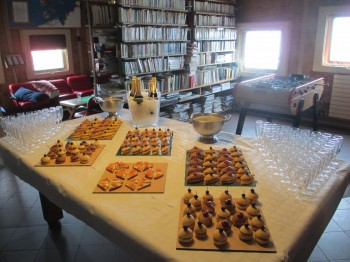
My second Christmas in Antarctica… I guess it’s becoming a habit now! Credits: ESA/IPEV/PNRA-A. Golemis
But going away is not negative or always gloomy. While glancing back is bittersweet, looking onward to the path that lays ahead can be inspiring. And this past can give you all the strength and determination to march on and achieve everything you need.
In summary, I do miss plenty of last year but I am also content to enjoy Antarctica’s wildlife and landscapes in a different place before returning home. In the twelve days we spent at Dumont D’Urville we celebrated (our second) Christmas in Antarctica and walked on the ice pack to visit Cap Prud’Homme again, skimming among icebergs upon the frozen sea and spotting a seal that came out to play. I finally had the chance to send postcards from Antarctica to friends and family. And I benefitted from the opportunity to briefly swim in the sea as well! This was not a bad ending after all. As someone once wrote, the road goes ever on and on… So here I leave you with a few pictures of the road so far. ҉

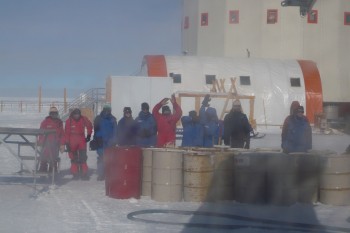
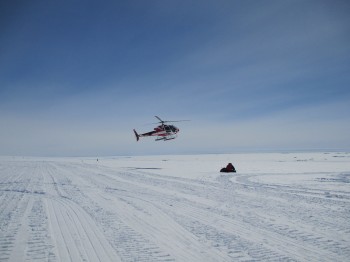

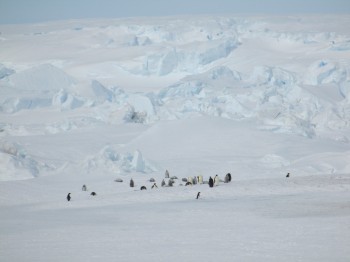
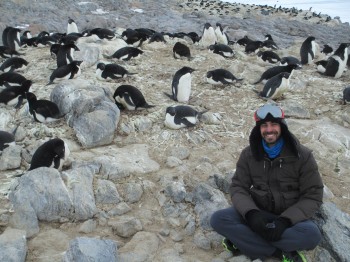




Discussion: 2 comments
What a heartwarming description from a cold place. Thanks for sharing your feelings!
Thanks for sharing this, from the coolest place in earth. Thank you for you hard work and research.